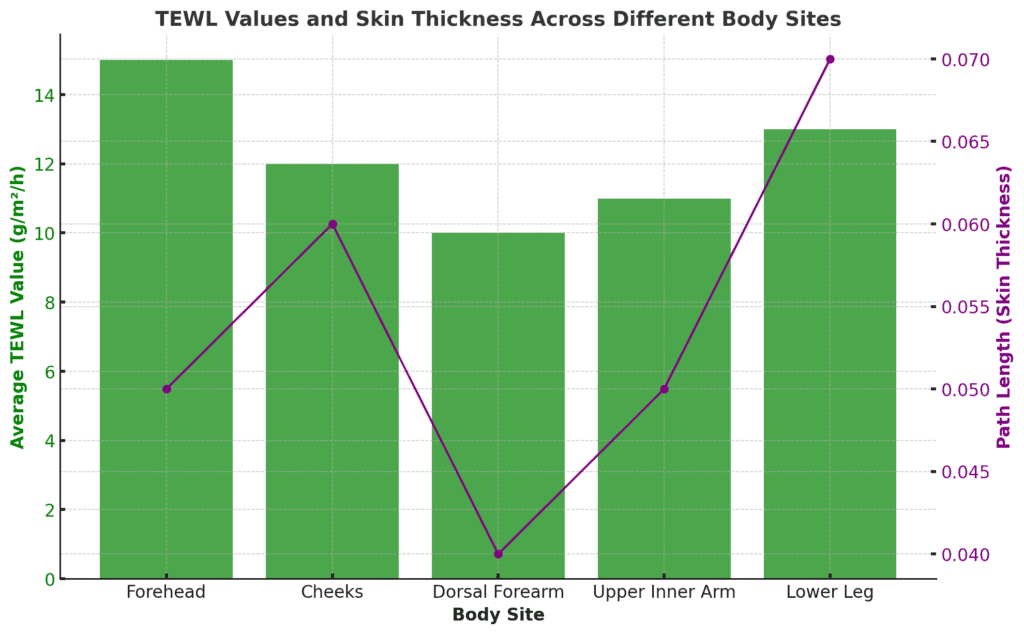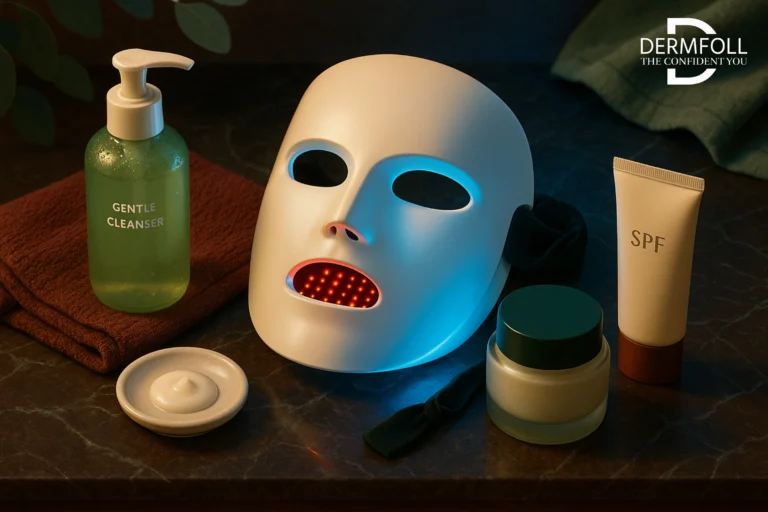Why aren’t your skincare products as effective as you had hoped them to be? Unbelievably, these might be the offenders causing you to have less-than-perfect skin. The hidden problem here is a term not many people know: Transepidermal Water Loss (TEWL In Skin).
Nobody likes to see dry, flaky skin when they look in the mirror. When nothing seems to work, it depressing, we get it.
Knowing the reason your skin loses water could be the difference you need. Our aim is to lead you through this sometimes overlooked part of skincare so that you may get the brilliant, healthy skin you soo want.
This section explores TEWL’s scientific foundation. We will define what it is, how it is measured, and why it is so important for the health of your skin.
We will talk about the following:
- TEWL basics and their relevance in skincare.
- Techniques used to calculate TEWL and the advantages and disadvantages of every approach.
- TEWL’s link with disorders including atopic dermatitis.
How would knowing about TEWL transform your skincare regimen? Consider your skin as a stronghold always guarding its moisture from outside dangers. A weakening barrier can feel like a lost struggle. Still, don’t sink in hopelessness. Your secret weapon can be knowledge of TEWL.
By the time you finish this 5 part series, you’ll have the knowledge required to decide on skincare more wisely.
Welcome to DERMFOLL. Lets get right into TEWL and your skin!
How Are Transepidermal water loss measurement made ?
Measurement of tewl (Transepidermal water loss) is an effective tool for evaluating skin health. measurement of tewl assesses the amount of water passing out from your body through the epidermis (outer most layer of the skin).
Accurate measurement of TEWL helps in assessing the integrity of your skin barrier. Quite vital for maintaining hydration and protecting against external stressors.
tewl assessment are made by various techniques. Well expand on this by seeing it through the lense of multiple studies.
What Devices Are Used In Transepidermal Water Loss Measurement
Open-Chamber Devices Are commonly used. Thy feature a hollow cylinder placed directly on the skin.
- As water vapor diffuses from the skin into the cylinder, sensors measure the humidity gradient. This method is effective due to the minimal disturbance to the skin’s natural microclimate.
- One major downside being that they can be influenced by external factors such as air movements. which can potentially influence the accuracy of the measurements.
Unventilated-Chamber Devices work by enclosing the skin in a chamber. The relative humidity within the chamber is measured, giving accurate TEWL readings.
- However, since the chamber must be lifted after each reading, i.e., to maintain an accurate reading, Real-time measurements are not possible with this method.
Condenser-Chamber Devices, a more advanced method for measuring TEWL. These have a closed chamber with a condenser cooled below the freezing point of water. As a condenser cooled below freezing efficiently collects water vapor, prevents saturation.
- This setup gives continuous and real-time TEWL measurements without interruption. Sensors within the chamber measure water vapor density. Providing highly sensitive and accurate readings.
- They may seem complex, with a higher price tag. However, these devices are preferred for their precision and ability to maintain a stable microclimate.
Which Transepidermal Water Loss Measurement Technique Is The Best
A comprehensive comparison of these measurement techniques reveals several key findings:
Performance and Accuracy: Comparative studies, such as those referenced by Imhof et al., indicate that condenser-chamber systems offer greater sensitivity. And especially in detecting the effects of skin treatments.
- These systems gave real-time and, hence, more reliable readings. Which made long-term monitoring and assessment of treatment safety more effective.
Environmental Control: Open-chamber devices, while less invasive, can be influenced by environmental disturbances.
- In contrast, unventilated and condenser-chamber devices seem less bothered by the environment. Giving accurate and reliable readings.
| Technique | Description | Advantages |
| Open-Chamber Devices | Hollow cylinder placed on skin; measures humidity gradient. | Minimal disturbance to skin’s microclimate. |
| Unventilated-Chamber Devices | Encloses skin in chamber; measures relative humidity. | Gives accurate TEWL readings. |
| Condenser-Chamber Devices | Closed chamber with condenser cooled below freezing; measures water vapor density. | Provides continuous, real-time TEWL measurements |
| Technique | Disadvantages | Real-Time Measurement Capability |
| Open-Chamber Devices | Influenced by external factors such as air movement. | No |
| Unventilated-Chamber Devices | Cannot provide real-time measurements. | No |
| Condenser-Chamber Devices | Complex and expensive. | Yes |
Why Is It Necessary To Have Accurate TEWL Measurements
Calibration and controlled measurement conditions are necessary for obtaining accurate and consistent TEWL readings. Proper calibration ensures that the devices used in these measurements provide reliable data.
Understanding various TEWL measurements and applications should be a mainstay when developing effective treatments. Especially for evaluating skin health while developing effective skincare treatments.
Accuracy is necessary in assessing the efficacy of moisturizers, barrier creams and everything in between. Especially when aimed at maintaining or restoring the skin’s barrier function.
How Does Tewl In Skin Relate To Skin Barrier Health
Transepidermal Water Loss (TEWL) gives valuable insights into skin barrier function. TEWL is a reliable indicator of skin permeability and barrier function. And Accurate TEWL measurements are necessary in better studying and treating skin conditions.
Here, we will assess how TEWL relates to skin barrier health. supported by findings from key studies.
Relation Between TEWL and Permeability Of The Skin
Research indicates a strong correlation between TEWL and skin permeability. A study titled “The Relationship Between Transepidermal Water Loss and Skin Permeability”. Investigated this link across different sites on the body.
They investigated the relationship between TEWL and the thickness (pathlength) of the skin’s outermost layer.
The researchers found that higher TEWL values correspond to higher skin permeability. Indicating an ailing or weak skin barrier. Key findings from the study include:
Reciprocal Relationship: There is a direct relationship between TEWL and path length through the stratum corneum (SC).
- This means that as the pathlength decreases, i.e. the thickness of the stratum corneum decreases. The amount of water lost increases. Ultimately, hydration in the skin decreases.
Site Variability: Sites with smaller corneocytes (skin cells). And fewer cell layers had higher TEWL values. Which indicates that thinner skin is more vulnerable to water loss. The key sites include:
- Forehead
- Cheeks
- Dorsal forearm
- Upper inner arm
- Lower leg
TEWL Values Across Different Body Sites
| area | Average TEWL | Thickness | skin cell Size | Number of Cell Layers |
|---|---|---|---|---|
| Forehead | 15 | 0.05 | Small | 10 |
| Cheeks | 12 | 0.06 | Medium | 12 |
| Dorsal Forearm | 10 | 0.04 | Medium | 8 |
| Upper Inner Arm | 11 | 0.05 | Small | 9 |
| Lower Leg | 13 | 0.07 | Large | 11 |

Purple Line: path length (skin thickness) for each body site.
Average TEWL Value (g/m²/h)
g/m²/h stands for grams per square meter per hour.
It measures the amount of water lost from the skin surface over an area of one square meter in one hour. Higher values indicate more water loss, which can mean a weaker skin barrier.
Path Length (Skin Thickness)
Path Length: Refers to the thickness of the outermost layer of the skin.
Is measured in millimeters (mm). Thicker skin (longer path length) usually means better protection and less water loss.
How Does Water Move Out Of The Skin?
The stratum corneum (SC), the skin’s outermost layer. Regulates skin hydration through its structural organization. The study on biological background and routes of water permeation emphasizes the following:
Intercellular Route Dominance: Water passes primarily through the outer layer via the spaces between the skin cells.
Lipid matrix importance: The stratum corneum contains a lipid matrix. This matrix is composed of lipophilic (fat-attracting) and hydrophilic (hydrating) compartments.
Which help maintain an effective water barrier. Any disruption in this lipid organization can lead to increased TEWL.
TEWL and Permeability Of The Skin
| Study | Correlation Coefficient | Body Sites | Key Findings | Indicates |
|---|---|---|---|---|
| Study 1 | 0.85 | Forehead, Cheeks | Higher TEWL values correspond to higher skin permeability. | Indicates weak skin barrier. |
| Study 2 | 0.78 | Arms, Legs | TEWL is inversely related to skin thickness. | Suggests thinner skin is more vulnerable to water loss. |
| Study 3 | 0.90 | Whole Body | Significant correlation between TEWL and barrier function. | Useful for evaluating treatment effectiveness. |
What Conditions Relate To TEWL
Atopic dermatitis (AD) is a chronic skin condition characterized by inflamed, itchy skin and a weakened skin barrier. TEWL is useful for assessing AD patients’ barrier function.
The study “Transepidermal Water Loss in Dry and Clinically Normal Skin in Patients with Atopic Dermatitis” provides critical insights:
Higher TEWL in AD patients: Compared to healthy individuals, AD patients exhibit higher TEWL. This indicates a compromised skin barrier that cannot retain moisture effectively.
Affected and Non-Affected Areas: Notably, even the unaffected skin areas in AD patients showed increased TEWL.
- This suggests that the barrier dysfunction in AD is not just limited to visibly affected areas but is also seen across the skin.
Relation Between Serum Antidiuretic Hormone in Severe Atopic Dermatitis
Antidiuretic hormone (ADH) is released when water levels in the body decrease. Normally seen in individuals with chronic or acute dehydration. ADH handles this by increasing thirst and retaining water from the kidneys.
A related study titled “Serum Antidiuretic Hormone in Relation to the Increase in Average Total Body Transepidermal Water Loss in Severe Atopic Dermatitis” examined how severe AD affects the body’s hydration status.
Here, We need to be clear about there relationship. Presence of Atopic Dermatitis in these individuals causes changes in ADH levels. And not the other way around.
Elevated ADH in Severe AD: Patients with severe AD had higher levels of serum antidiuretic hormone (ADH).
- which helps regulate water balance in the body. This elevation is a response of the body to increased water loss. Which was primarily through the damaged skin barrier.
Correlation with AD Severity: Both TEWL and ADH levels were strongly associated with Atopic Dermatitis.
- Severe AD patients reported symptoms such as increased thirst and nocturnal sweats. This is body’s attempt to compensate for the significant water loss by releasing ADH.
CONCLUSION
you are well-versed in introduction to Transepidermal Water Loss (TEWL). And have another piece to the puzzle to enhance your skincare routine.
We’ve discussed the science of TEWL, explored various measurement techniques. And discussed why TEWL is vital for achieving healthy, hydrated skin. You’ve learned that a weakened skin barrier can increase TEWL, leading to dryness and irritation, and how precise measurements can guide better skincare choices.
Head over to the next post where talk in detail about TEWL and RF skincare technology (our quarterly series, focused on RF skincare tech). Should you use Rf skincare treatments when Skin barrier function is compromised?








